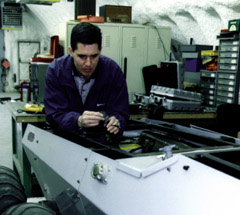
Until recently, robots only existed in the fevered imagination of science
fiction writers. The very word "robotics" was coined not by a researcher
but by famed science fiction author Isaac Asimov, way back in the 1940's.
Chris Brosinsky, an Aeromechanical Design Technologist who heads
a research group working for the Canadian military, is now helping to
make those robot dreams a reality. |
 |
 |
 |
Chris, 34, has been working for the Defence Research Establishment,
Suffield (DRES) since he graduated from the Southern Alberta Institute
of Technology (SAIT) in 1984. Chris and his colleagues at DRES,
run by the Department of National Defence, research and develop
military technologies for the Canadian Forces. If the Forces indicate
interest in a particular project, DRES seeks out Canadian manufacturers
to build the final product. "In our organization," says Chris, "a
success is a concept attractive enough that the military says 'yes.'
Then we find a Canadian company to actually perform the work."
Chris works in the Vehicle Concepts Group doing research on unmanned,
robotic vehicles. Chris finds the world of robotics very exciting,
particularly the way machines are starting to perform the hazardous
or mundane tasks humans were once obliged to do. "We research and
develop all forms of robotic-vehicle controls," continues Chris.
"These control everything, from the vehicle itself to the data-links
that communicate back and forth to the vehicle, to the payloads
that go on it." While working out the mechanical requirements of
a particular project, Chris's primary concern is the mobility of
the prototype. Based on his research, Chris makes recommendations
that range from the type of oil used in the engine, to the mechanical
embodiment of the system - its size, power, and speed.
Involved in all levels of a project's development, Chris often dons
the hat of both project manager and technologist engineer. His responsibilities
include everything from conceptualization, design, development,
prototyping, testing, and even drafting the contracts with manufacturers.
At the early stages, Chris consults with a group of four to ten
people, to examine a concept and begin research. A prototype is
then designed and developed using both traditional models made of
plastic and metal as well as computer simulations. If the military
responds positively to the prototype, a manufacturer is located,
Military Specifications ("Mil Spec") are drafted, and a new contract
begins.
The development of a robotics project depends on a wide range of
technologies including electronics, computing, and mechanical engineering.
|
 |
| |
|
|


